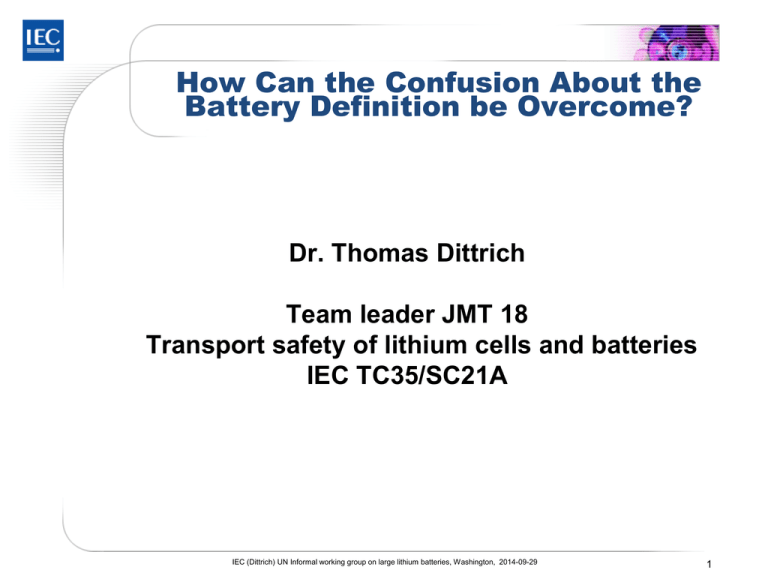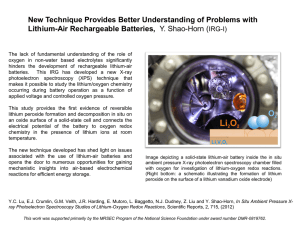Battery Definition (IEC)
advertisement

How Can the Confusion About the Battery Definition be Overcome? Dr. Thomas Dittrich Team leader JMT 18 Transport safety of lithium cells and batteries IEC TC35/SC21A IEC (Dittrich) UN Informal working group on large lithium batteries, Washington, 2014-09-29 1 Outline - Battery Definition DGAC proposal Battery Definition UN vs. IEC Why did the UN change the battery definition? Can the DGAC proposal overcome the confusion? How can confusion be overcome with a harmonized battery definition? Other sources of confusion Summary IEC (Dittrich) UN Informal working group on large lithium batteries, Washington, 201409-29 2 Battery Definition – DGAC Proposal The DGAC proposes to include the definitions for “lithium cell”, “battery” and “single cell battery” in the Model Regulations These terms are now only defined in the Manual of Tests and Criteria Consignors must understand the difference between a cell and battery in order to comply with the exceptions provided in SP 188 Common consignors do not generally acquire or have access to the Manual of Tests and Criteria Source: UN working document ST/SG/AC.10/C.3/2014/90 (46th SCETDG) IEC (Dittrich) UN Informal working group on large lithium batteries, Washington, 201409-29 3 Battery Definition – UN vs. IEC UN Manual of Tests and Criteria Battery definition See Rev. 1 Rev. 2 Rev. 3 Rev. 3, Amend. 1 - 2002 ...means one or more cells ... Rev. 4 - 2003 ...means one or more cells ... Rev. 5 - 2009 ...means one or more cells ... Slide 27 Rev. 5, Amend. 1 - 2011 ...means two or more cells ... Slide 28 IEC International Electrotechnical Vocabulary or IEV Battery definition IEC 60050, 482-01-04 Publication date: 2004-04 ...means one or more cells ... IEC (Dittrich) UN Informal working group on large lithium batteries, Washington, 201409-29 Slide 29 4 Why did the UN change the battery definition? The current definition in Section 38.3.2.2 stated that “Battery means one or more cells which are electrically connected together ----- “. While this definition is consistent with the reality that single cell is used as a “battery” in many applications, it causes the difficulty and confusion with regards to implementation of testing requirement for cell and battery. The current definition for battery is also inconsistent with the definition of “cell” given in Section 38.3.2.2. In fact the explanation given in the definition of “cell” implies that a single cell shall be treated as “cell” not “battery”. Source: US proposal to the U.N. Lithium Battery Informal Working Group, 3rd Meeting, Nov. 9 – 11, 2009, Kyoto, Japan IEC (Dittrich) UN Informal working group on large lithium batteries, Washington, 201409-29 5 Battery Definition – Can the DGAC Proposal Overcome the Confusion? No. The UN battery definition is not helpful, because Consigners do not normally know the number of cells in a battery • Consigners can refer to manufacturers‘ data sheets which will most likely be based on the IEC definition • Consigners can refer to what is written on the battery Consigners will be confronted with a conflicting battery definition in „reality“ (term used in the Kyoto US proposal) The UN definitions for „cell“, „battery“ and „single cell battery“ are confusing in themselves. The UN definitions state that a „single cell battery“ is a „cell“, not a „battery“. Such a terminology is not self consistent and will always remain confusing. IEC (Dittrich) UN Informal working group on large lithium batteries, Washington, 201409-29 6 Battery Definition – Can the DGAC Proposal Overcome the Confusion? The term „BATTERY“ is used on „cells“ IEC (Dittrich) UN Informal working group on large lithium batteries, Washington, 201409-29 7 Battery Definition – Can the DGAC Proposal Overcome the Confusion? What looks like a „cell“ is a battery (here comprising 2 cells) IEC (Dittrich) UN Informal working group on large lithium batteries, Washington, 201409-29 8 Battery Definition – Can the DGAC Proposal Overcome the Confusion? Multilingual IEC definition readily available in „Electropedia“ IEC (Dittrich) UN Informal working group on large lithium batteries, Washington, 201409-29 9 How can confusion be overcome with a harmonized battery definition? Model Regulations, Rev. 18: Special Provision 188 b) For a lithium metal or lithium alloy battery the aggregate lithium content is not more than 2 g, and for a lithium ion battery, the Watt-hour rating is not more than 100 Wh… Add: Each component cell of a battery shall not exceed the limit for a cell. Special Provision 188 f) or no more than four cells installed in equipment Add: or single cell batteries or no more than two batteries installed in equipment Add: multicell IEC (Dittrich) UN Informal working group on large lithium batteries, Washington, 201409-29 10 How can confusion be overcome with a harmonized battery definition? Manual of Tests and Criteria, Rev. 5 Amend. 1: 38.3.2.3 Battery means two or more cells which are electrically connected together and fitted with devices necessary for use, for example, case, terminals, marking and protective devices. A single cell battery is considered a "cell" and shall be tested according to the testing requirements for "cells" for the purposes of the Model Regulations and this Manual (see also the definition for "cell"). Replace “two or more cells” with “one or more cells”. Delete “A single cell battery is considered a "cell" …” IEC (Dittrich) UN Informal working group on large lithium batteries, Washington, 201409-29 11 How can confusion be overcome with a harmonized battery definition? Manual of Tests and Criteria, Rev. 5 Amend. 1: 38.3.2.3 Cell means a single encased electrochemical unit (one positive and one negative electrode) which exhibits a voltage differential across its two terminals. Under the Model Regulations and this Manual, to the extent the encased electrochemical unit meets the definition of "cell" herein, it is a "cell", not a "battery", regardless of whether the unit is termed a "battery" or a "single cell battery" outside of the Model Regulations and this Manual. Delete “Under the Model Regulations and this Manual, to the extent the encased electrochemical unit meets the definition of "cell" herein, it is a "cell", not a "battery", …” IEC (Dittrich) UN Informal working group on large lithium batteries, Washington, 201409-29 12 How can confusion be overcome with a harmonized battery definition? Manual of Tests and Criteria, Rev. 5 Amend. 1: 38.3.2.3 Single cell battery means a single electrochemical unit fitted with devices necessary for use, for example, case, terminals, marking and protective devices. Delete this definition or replace it with the following one: Single cell battery means a battery with one component cell. If considered necessary, add the following definition: Multicell battery means a battery with two or more component cells. IEC (Dittrich) UN Informal working group on large lithium batteries, Washington, 201409-29 13 How can confusion be overcome with a harmonized battery definition? Manual of Tests and Criteria, Rev. 5 Amend. 1: 38.3.3 (a) … (i) ten cells in undischarged states; (ii) ten cells in fully discharged states; (iii) four small batteries in undischarged states; (iv) four small batteries in fully discharged states; (v) four large batteries in undischarged states; and (vi) four large batteries in fully discharged states. Replace “cells” with “cells or single cell batteries” Replace “batteries” with “multicell batteries” IEC (Dittrich) UN Informal working group on large lithium batteries, Washington, 201409-29 14 How can confusion be overcome with a harmonized battery definition? Manual of Tests and Criteria, Rev. 5 Amend. 1: 38.3.3 (b) same change as in 38.3.3 (a) 38.3.3 (c) no change required 38.3.3 (d) When testing rechargeable batteries or rechargeable single cell batteries under test T.7, the following shall be tested in the quantity indicated: Delete “or rechargeable single cell batteries” Batteries not equipped with overcharge protection that are designed for use only in a battery assembly, which affords such protection, are not subject to the requirements of this test. This paragraph was not changed when the UN changed the battery definition. Therefore, it may have changed its meaning. IEC (Dittrich) UN Informal working group on large lithium batteries, Washington, 201409-29 15 Other sources of confusion Manual of Tests and Criteria, Rev. 5 Amend. 1: 38.3 Lithium metal and lithium ion batteries The title of chapter 38.3 and, in fact, the proper shipping names of UN 3090, 3091, 3480, 3481 may be less confusing if the term “batteries” does not exclude single cell batteries. If the battery definition cannot be changed then it may have to be considered to change the title of chapter 38.3 and the proper shipping names so as to replace “batteries” with “cells and batteries”. However, the IEC proposes rather to harmonize the battery definition. IEC (Dittrich) UN Informal working group on large lithium batteries, Washington, 201409-29 16 Other sources of confusion Manual of Tests and Criteria, Rev. 5 Amend. 1: 38.3.2.3 Large battery means a lithium metal battery or lithium ion battery with a gross mass of more than 12 kg. This definition was not changed when the UN changed the battery definition. Large cell means a cell with a gross mass of more than 500 g. This definition was changed when the UN changed the battery definition. However, it seems not to harmonize with the Large battery definition. Also consider the following definitions: Small battery ... Small cell ... IEC (Dittrich) UN Informal working group on large lithium batteries, Washington, 201409-29 17 Other sources of confusion Manual of Tests and Criteria, Rev. 5 Amend. 1: 38.3.3 (e) no change required. But the mentioning of cells and, separately, component cells may be redundant 38.3.3 (f) When testing a battery assembly …, that is assembled from batteries that have passed all applicable tests … This paragraph was changed when the UN changed the battery definition. Therefore, it may require consideration. IEC (Dittrich) UN Informal working group on large lithium batteries, Washington, 201409-29 18 Other sources of confusion Manual of Tests and Criteria, Rev. 5 Amend. 1: 38.3.3 after (f) When batteries that have passed all applicable tests are electrically connected to form a battery assembly in which the aggregate lithium content of all anodes, when fully charged, is more than 500 g, or in the case of a lithium ion battery, with a Watt-hour rating of more than 6 200 Watt-hours, that battery assembly does not need to be tested if it is equipped with a system capable of monitoring the battery assembly and preventing short circuits, or over discharge between the batteries in the assembly and any overheat or overcharge of the battery assembly. This paragraph was not changed when the UN changed the battery definition. Therefore, it may have changed its meaning. IEC (Dittrich) UN Informal working group on large lithium batteries, Washington, 201409-29 19 Other sources of confusion Manual of Tests and Criteria, Rev. 5 Amend. 1: 38.3.4 Procedure Tests T.1 to T.5 shall be conducted in sequence on the same cell or battery. Tests T.6 and T.8 shall be conducted using not otherwise tested cells or batteries. Test T.7 may be conducted using undamaged batteries previously used in tests T.1 to T.5 for purposes of testing on cycled batteries. No change required. However, if the battery definition is not harmonized, it may be considered to add “and single cell batteries” after “undamaged” and after “cycled”. IEC (Dittrich) UN Informal working group on large lithium batteries, Washington, 201409-29 20 Other sources of confusion Manual of Tests and Criteria, Rev. 5 Amend. 1: 38.3.4.3.2 Test procedure Cells and batteries are firmly secured to the platform of the vibration machine without distorting the cells in such a manner as to faithfully transmit the vibration. The vibration shall be a sinusoidal waveform with a logarithmic sweep between 7 Hz and 200 Hz and back to 7 Hz traversed in 15 minutes. This cycle shall be repeated 12 times for a total of 3 hours for each of three mutually perpendicular mounting positions of the cell. One of the directions of vibration must be perpendicular to the terminal face. No change required, but “cell” may have to be replaced with “cell or battery” IEC (Dittrich) UN Informal working group on large lithium batteries, Washington, 201409-29 21 Other sources of confusion Manual of Tests and Criteria, Rev. 5 Amend. 1: 38.3.4.4.2 Test procedure ... However, large cells and large batteries shall be subjected to a half-sine shock of peak acceleration of 50 gn and pulse duration of 11 milliseconds. Each cell or battery is subjected to three shocks in the positive direction followed by three shocks in the negative direction of each of three mutually perpendicular mounting positions of the cell for a total of 18 shocks. No change required, but “cell” may have to be replaced with “cell or battery” IEC (Dittrich) UN Informal working group on large lithium batteries, Washington, 201409-29 22 Other sources of confusion Manual of Tests and Criteria, Rev. 5 Amend. 1: 38.3.4.6.2 Test procedure – Impact (applicable to cylindrical cells greater than 20 mm in diameter) The sample cell or component cell is to be placed on a flat smooth surface. A 15.8 mm ± 0.1mm diameter, at least 6 cm long, or the longest dimension of the cell, whichever is greater, Type 316 stainless steel bar is to be placed across the centre of the sample. No change required, but “or component cell” may be redundant. Same in 38.3.4.6.3 and 38.3.4 6.4 IEC (Dittrich) UN Informal working group on large lithium batteries, Washington, 201409-29 23 Summary The DGAC proposal cannot prevent confusion of consigners Since 2011, the battery definitions of the UN and the „Reality“ are not harmonized The UN had a reason to change the battery definition but the same result could have been achieved by other means – without causing confusion This presentation shows the changes (in red) that would have had the same effect as the change of the battery definition It also identifies (in green) potential conflicts created by the change of definition as well as possible solutions. IEC (Dittrich) UN Informal working group on large lithium batteries, Washington, 201409-29 24 Thank you for your attention. Any questions? Battery Definition – UN Manual Rev. 5 Battery means one or more cells which are electrically connected together by permanent means, including case, terminals, and markings. NOTE: Units that are commonly referred to as "battery packs", "modules" or "battery assemblies" having the primary function of providing a source of power to another piece of equipment are for purposes of these Regulations treated as batteries. Cell means a single encased electrochemical unit (one positive and one negative electrode) which exhibits a voltage differential across its two terminals. Under these Regulations, to the extent the encased electrochemical unit meets the definition of "cell" herein, it is a "cell", not a "battery", regardless of whether the unit is termed a "battery" or a "single cell battery" outside of these Regulations. IEC (Dittrich) UN Informal working group on large lithium batteries, Washington, 201409-29 26 Battery Definition – UN Manual Rev. 5, Amend. 1 Battery means two or more cells which are electrically connected together and fitted with devices necessary for use, for example, case, terminals, marking and protective devices. A single cell battery is considered a "cell" and shall be tested according to the testing requirements for "cells" for the purposes of the Model Regulations and this Manual (see also the definition for "cell"). NOTE: Units that are commonly referred to as "battery packs", "modules" or "battery assemblies" having the primary function of providing a source of power to another piece of equipment are for purposes of these Regulations treated as batteries. Cell means a single encased electrochemical unit (one positive and one negative electrode) which exhibits a voltage differential across its two terminals. Under these Regulations, to the extent the encased electrochemical unit meets the definition of "cell" herein, it is a "cell", not a "battery", regardless of whether the unit is termed a "battery" or a "single cell battery" outside of these Regulations. IEC (Dittrich) UN Informal working group on large lithium batteries, Washington, 201409-29 27 Battery Definition – International Electrotechnical Vocabulary (IEV) battery one or more cells fitted with devices necessary for use, for example case, terminals, marking and protective devices cell basic functional unit, consisting of an assembly of electrodes, electrolyte, container, terminals and usually separators, that is a source of electric energy obtained by direct conversion of chemical energy component cell, single cell battery, multicell battery Note: these terms have no definitions but are self-explanatory IEC (Dittrich) UN Informal working group on large lithium batteries, Washington, 201409-29 28







